Documents: Go to download!
User Manual
- User Manual - (English)
- User Guide - (Spanish)
- Installation Instructions - (English)
- Product Specifications Sheet - (English)
- BEFORE SETTING SURFACE CONTROLS
- SETTING SURFACE CONTROLS
- BEFORE USING OVEN
- OVEN CONTROLS
- CARE AND CLEANING
- BEFORE YOU CALL
Table of contents
User manual Gas Range
BEFORE SETTING SURFACE CONTROLS
Using Proper Cookware
The size and type of cookware used will influence the heat setting needed for best cooking results. Be sure to follow the recommendations for using proper cookware as illustrated in Figure 1 and Figure 2.
Check for flatness by rotating a ruler across the bottom of the cookware (see Figure 1). Cookware should have flat bottoms that make good contact with the entire surface of the heating element (see Figure 2).
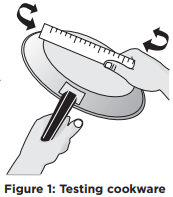
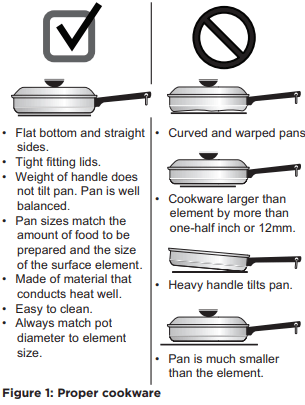
Cookware Material Types
The cookware material determines how evenly and quickly heat is transferred from the surface element to the pan bottom. The most popular materials available are:
- Aluminum - Excellent heat conductor. Some types of food will cause it to darken (Anodized aluminum cookware resists staining and pitting).
- Copper - Excellent heat conductor but discolors easily (see Aluminum).
- Stainless - Slow heat conductor with uneven cooking results. Durable, easy to clean, and resists staining.
- Cast Iron - A slow heat conductor, but will retain heat very well. Cooks evenly once cooking temperature is reached.
- Porcelain-enamel on metal - Heating characteristics will vary depending on base material.
- Glass - Slow heat conductor.
IMPORTANT Do not place empty aluminum, glass, or porcelainenamel coated cookware on the ceramic cooktop. The melting point of cookware made with these materials may be reached quickly, especially if left empty, and they may bond to the ceramic cooktop. If the cookware melts it will damage the cooktop. Follow all the cookware manufacturer’s recommendations for use and care of cookware.
IMPORTANT NEVER place or straddle a cooking utensil over two different surface cooking areas at the same time. Incorrect use may damage the cooktop.
Assembly of the Burner Caps
Make sure that all of the surface burner caps and surface burner grates are installed correctly and at the correct locations.
- Remove all packing material from the cooktop area.
- Make sure burner caps are properly placed on the surface burners.
The burner head has a hole which fits over the ignitior. Make sure the head fits sugly before placing the burner caps.
Unpack the burner grates and position them on the cooktop after the burner heads and caps are properly installed.
On round-style burners, the burner cap lip (Figure 3) should fit snug into the center of the burner head and rest level. Refer to Figure 4 for correct and incorrect burner cap placement.
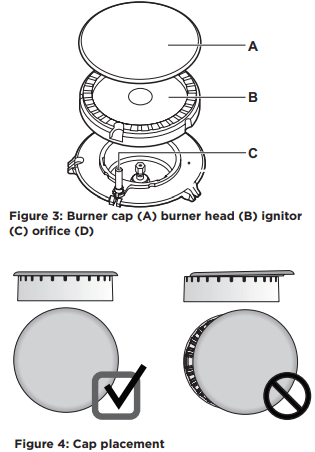
Once in place, you may check the fit by gently sliding the burner cap from side to side (Figure 3) to be sure it is centered and firmly seated. When the burner cap lip makes contact inside the center of the burner head you will be able to hear the burner cap click.
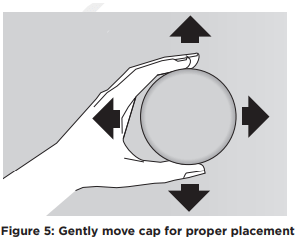
IMPORTANT
Please note that the burner cap should not move off the center of the burner head when sliding from side to side.
- Do not use the surface burners without the burner caps properly installed. Improperly seated burner caps may prevent burners from lighting or cause uneven flame and heating.
- Missing pieces or improper installation may lead to spills, burns, or damage to your range and cookware.
- Never place flammable items on the cooktop.
CAUTION
- Do not allow spills, food, cleaning agents, or any other material to enter the gas orifice holder opening.
- Always keep the burner caps and burner heads in place whenever the surface burners are in use.
- Never place flammable items on the cooktop.
Install Burner Grates
To install burner grates, place the grates flat-side down and align them into the cooktop recess.
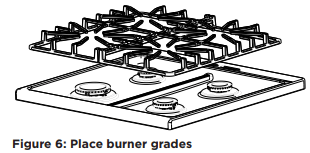
IMPORTANT
- Make sure the burner grates are properly placed on the cooktop before using the surface burners (Figure 6). The grates are designed to rest inside the recess on the cooktop.
- Grates should rest flush against each other and against the sides of the recess.
- Do not line the area underneath the grates or any part of the cooktop with aluminum foil or with any other lining.
Gas surface burner types
The cooktop is equipped with gas surface burners with different BTU ratings. The ability to heat food quickly and in large amounts increases as the burner size increases.
- Small burners are best used for low-flame heating of small amounts of food.
- Standard burners can be used for most surface cooking needs.
- The largest burner is best used for bringing large quantities of liquid rapidly up to temperature or when preparing larger quantities of food. The large burner is located at the right front position on the cooktop.
Regardless of size, always select cookware that is suitable for the amount and type of food being prepared. Select a burner and set the flame size appropriately for the pan. Never allow flames to extend beyond the outer edge of the pan.
Home Canning
Be sure to read and observe all the following points when home canning with your appliance. Check with the USDA (United States Department of Agriculture) Web site and be sure to read all the information they have available as well as follow their recommendations for home canning procedures.
- Use only a completely flat bottom canner with no ridges that radiate from the bottom center when home canning. Heat is spread more evenly when the bottom surface is flat. Use a straight-edge to check canner bottom.
- Make sure the diameter of the canner does not exceed 1 inch beyond the surface element markings or burner.
- It is recommended to use smaller diameter canners and to center canners on the burner grates.
- Start with hot tap water to bring water to boil more quickly.
- Use the highest heat setting when first bringing the water to a boil. Once boiling is achieved, reduce heat to lowest possible setting to maintain that boil.
- Use tested recipes and follow instructions carefully. Check with your local Cooperative Agricultural Extension Service or a manufacturer of glass jars for the latest canning information.
- It is best to can small amounts and light loads.
- Do not leave water bath or pressure canners on high heat for an extended amount of time.
SETTING SURFACE CONTROLS
Setting surface controls
The ability to heat food quickly and in large volumes increases as the burner size increases. Your gas appliance may be equipped with many different sized surface burners.
It is important to select cookware that is suitable for the amount and type of food being prepared. Select a burner and flame size appropriate for the cookware size.
- The standard size burner or burners may be used for most surface cooking needs.
- Small burners are best used for low-flame heating of small amounts of food.
- Large burners are best for bringing large quantities of liquid to temperature or heating larger quantities of food.
Setting a surface burner:
- Place cooking utensil on center of surface burner grate. Be sure the cooking utensil rests stable on the burner grate.
- Push the burner’s surface control knob in and turn counterclockwise out of the OFF position (Figure 7).
- Release the surface control knob and rotate to the LITE position (
 ). Visually check that the burner has a steady gas flame.
). Visually check that the burner has a steady gas flame. - Once the surface burner has a flame, push the surface control knob in and turn counterclockwise to the desired flame size setting. Adjust the flame as needed using the knob markings.
IMPORTANT
- NEVER place or straddle a cooking utensil over two different surface cooking areas at the same time unless the cookware is specifically designed for the purpose.
- DO NOT cook with a surface control knob left in the lite position (
 ). The electronic ignitor will continue to spark. Turn the control knob out of the lite position and adjust the flame size.
). The electronic ignitor will continue to spark. Turn the control knob out of the lite position and adjust the flame size. - Do not place aluminum foil, or ANY material that can melt on the range cooktop. If items melt, they may permanently damage the appearance of the cooktop.
CAUTION Do not place flammable items such as plastic wrappings, spoon holders, or plastic salt and pepper shakers on the cooktop when it is in use. These items could melt or ignite. Potholders, towels, or wooden spoons could catch fire if placed too close to the surface burners.

NOTE
- When setting a surface control knob to the lite position, all of the electronic surface ignitors will spark at the same time. However, only the surface burner you are setting will ignite.
- In the event of an electrical power outage, the surface burners may be lit manually. To light a surface burner, hold a lit match to the burner head, then slowly turn the surface control knob to lite. Once the burner ignites, push in and turn knob out of lite then to the desired flame setting. Use caution when lighting surface burners manually.
BEFORE USING OVEN
Set proper burner flame size
The color of the flame is the key to proper burner adjustment. A good flame is clear, blue and hardly visible in a well-lighted room. Each cone of flame should be steady and sharp. Adjust or clean the burner if flame is yellow-orange.
For most cooking: start on the highest setting and then turn to a lower setting to complete the process. Use the recommendations below as a guide for determining proper flame size for various types of cooking (Table 1).
For deep fat frying: use a thermometer and adjust the surface knob accordingly. If the fat is too cool, the food will absorb the fat and be greasy. If the fat is too hot, the food will brown so quickly that the center will be under-cooked. Do not attempt to deep fat fry too much food at once as the food will neither brown nor cook properly
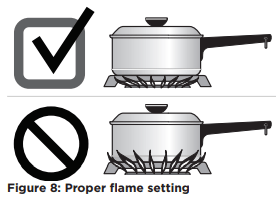
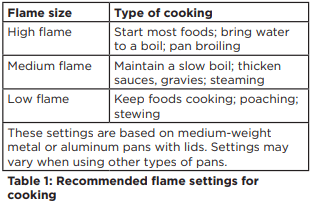
CAUTION Never extend the flame beyond the outer edge of the cooking utensil. A higher flame wastes energy, and increases your risk of being burned by the flame (Figure 2).
Cooking with a griddle (some models)
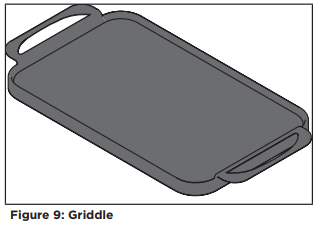
The griddle is a versatile accessory that is perfect for cooking foods that require large flat surfaces such as pancakes, French toast, grilled sandwiches, bacon, and also for cooking different foods at the same time.
After use, let the griddle cool before washing. Hand wash with hot soapy water. Do not soak. Dry thoroughly. Do not put a griddle in a dishwasher.
Using the griddle:
Place the griddle securely on top of the burner grates. Preheat the griddle for 5 minutes on medium to medium low setting. Slow preheat ensures even heat distribution during the cooking process. DO NOT preheat the griddle on HI setting. Preheating on HI may warp the griddle and prevent even heat distribution.
Oven Vent Location (some models)
The oven vent is located under the control panel. When the oven is on, warm air passes through this vent.. This venting is necessary for proper air circulation in the oven and good baking results. Do not block the oven vent. Never close off the openings with aluminum foil or any other material. Steam or moisture may appear near the oven vent. This is normal.
The Cooling Fan (some models)
The cooling fan operates during cooking. Air is expelled through the vents between the oven door and the control panel as shown in Figure 10.
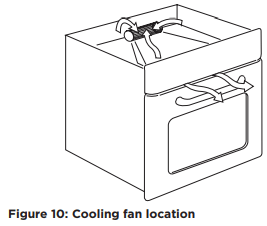
WARNING Protective Liners — Do not use aluminum foil or any other material or liners to line the oven bottom, walls, racks or any other part of the range. Doing so will alter the heat distribution, produce poor baking results, and possibly cause permanent damage to the oven interior. Improper installation of these liners may result in risk of electric shock or fire. During self clean, temperatures in the oven will be hot enough to melt foil.
CAUTION
- Always use pot holders or oven mitts when using the oven. When cooking, the oven interior, oven exterior, oven racks, and cooktop will become very hot which can cause burns.
- To prevent possible damage to the oven, do not attempt to close the oven door until all the oven racks are fully positioned back inside the oven cavity
Flat Oven Rack

Flat oven racks may be used for most cooking needs and may be placed in most oven rack positions.
Removing, Replacing, and Arranging Flat or Offset Oven Racks
Always arrange the oven racks when the oven is cool.
To remove - Pull the oven rack straight forward until it reaches the stop position. Lift up front of oven rack slightly and slide out.
To replace - Place the oven rack on the rack guides on both sides of oven walls. Tilt the front of oven rack upward slightly and slide the oven rack back into place. Be sure oven racks are level before using.

Air Circulation in the Oven
The rack has a special shape in the rear which helps with the heat circulation.
Do not push the baking tray all the way to the back wall of the cavity. This prevents the heat from circulating around the tray. The food may be burnt, especially in the rear part of the tray.
For best air circulation when baking, allow a space of 2 inches (5 cm) around the cookware for proper air circulation. Be sure pans and cookware do not touch each other, the oven door, sides, or back of the oven cavity.
Hot air must be able to circulate around cookware for even heat to reach the food.
OVEN CONTROLS
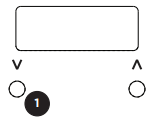

Oven Control Features
- Up / Down arrows - Use to adjust and set the appliance’s timer functionality.
- Oven temp knob - Use to select the desired cooking temperature.
- Oven indicator light - Glows when the oven is set to broil.
- Oven light - Use this switch to turn the internal oven light on or off.
Operating oven light
Press the oven light switch (4) located on the control panel to turn the interior oven light on and off whenever the oven door is closed.
The interior oven light is located at the upper right rear wall of the oven interior. To change the interior oven light, see “Changing the oven light” in the Care & Cleaning section.
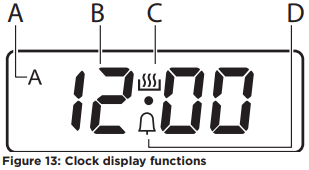
Setting the Clock
When the appliance is first plugged in or when the power supply to the appliance has been interrupted, the display will flash 0:00. It is recommended to always set the clock for the correct time of day before using the appliance.
To set the clock:
- Press both
 and
and  at the same time. The time in the display will stop flashing. The dot in the middle of the display will flash.
at the same time. The time in the display will stop flashing. The dot in the middle of the display will flash. - Use
 or
or  to set the correct time of day. After approximately five seconds, the dot in the display stops flashing and the display shows the time of day you set.
to set the correct time of day. After approximately five seconds, the dot in the display stops flashing and the display shows the time of day you set.
NOTE On some models, the time of day is a 24-hour clock and cannot be changed to 12 hours.
Timer Functions
To set the timer:
- Press
 or
or  to set the desired time. The
to set the desired time. The  icon flashes, and the time remaining will appear in the display. After 5 seconds, the
icon flashes, and the time remaining will appear in the display. After 5 seconds, the  icon will stop flashing, and the countdown will begin.
icon will stop flashing, and the countdown will begin. - When the time ends, the function’s indicator on the display will start flashing and a signal will sound for six minutes. Press any button to stop the signal.
Setting Bake
Use the bake feature whenever the recipe calls for baking using normal temperatures.
CAUTION
- Always use pot holders or oven mitts when using the oven. When cooking the oven interior, oven racks, and cooktop will become very hot which can cause burns.
- Do not bake foods directly on the oven bottom. To avoid damaging the oven interior and surfaces, always bake foods in the oven using bakeware positioned on an oven rack.
To set Bake:
- Arrange oven racks while the oven is still cool.
- Turn the oven temp knob to the spark position (
 ) and press the knob to ignite the oven burner.
) and press the knob to ignite the oven burner. - After the burner lights, turn the knob to the desired temperature.
- Allow the oven to preheat for 15 minutes before baking. Preheating is not necessary when roasting, cooking casseroles, or broiling most foods.
- To cancel the baking function, turn the oven temp knob to the OFF position.
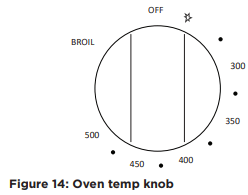

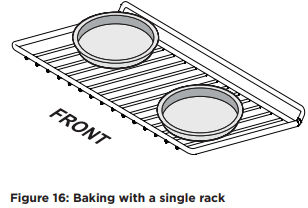
IMPORTANT For this appliance, single rack radiant bake is the recommended bake function for best results for batter and dough-based baked goods such as cakes, pastries, and breads.
- For best results when baking with one oven rack, place racks in positions 2 or 3 (Figure 15).
- When baking using one oven racks, position bakeware as shown in Figure 16. Allow at least 2 inches (5 cm) of space between bakeware for proper air circulation.
NOTE The baking image is correct, but it’s also for presentation purposes. You may also bake with the left pan in the front and the right pan in the back. Either position for either pan bakes correctly
General Baking Tips:
- Preheat the oven 15 minutes before baking items like cookies, biscuits, cakes, and breads.
- Dark or dull pans absorb more heat than shiny bakeware, resulting in dark or over browning of foods. It may be necessary to reduce the oven temperature or cook time to prevent over browning of some foods. Dark pans are recommended for pies. Shiny pans are recommended for cakes, cookies, and muffins.
- Do not open the oven door too often. Opening the door will reduce the temperature in the oven.
- Glass bakeware is a slow heat conductor. May require reducing oven temperature.
Setting Broil
Use to cook meats that require direct exposure to radiant heat for optimum browning results. Position the rack as suggested in Table 3.
To set Broil:
- Arrange the oven rack while oven is still cool.
- Turn the oven temp knob to the Broil position (Figure 14). For optimum results, preheat broil for 10 minutes before adding food.
- Place the insert on the broil pan (if equipped), then place the food on the broil pan insert (if using a broiler pan and insert). To purchase a broiling pan and insert, visit frigidaire.com
- Place the broiler pan and insert on the oven rack. Center the broiler pan directly under the broiler element. Broil on one side until food is browned. Always pull the oven rack out to the stop position before turning or removing food. Turn and broil food on the second side.
- To cancel the broiling function, turn the oven temp knob to the OFF position.
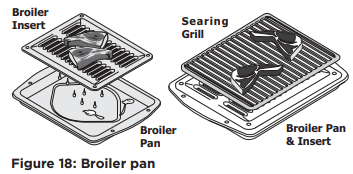
WARNING
Should an oven fire occur, keep oven door closed and turn off the oven. If the fire continues, throw baking soda on the fire or use a fire extinguisher. Do not put water or flour on the fire. Flour may be explosive and water can cause a grease fire to spread and cause personal injury.
The broiler pan and the insert allow grease to drain and be kept away from the high heat of the broiler. Do not use the pan without the insert. Do not cover the insert with aluminum foil; the exposed grease could ignite.
CAUTION Always use pot holders or oven mitts when using the oven. When cooking, the oven interior, oven racks, and cooktop will become very hot which can cause burns.

CARE AND CLEANING
Remove spills and any heavy soiling as soon as possible. Regular cleaning will reduce the difficulty of major cleaning later.
CAUTION
- Before cleaning any part of the appliance, be sure all controls are turned off and the appliance is cool.
- If ammonia or appliance cleaners are used, they must be removed and the appliance must be thoroughly rinsed before operating. Follow manufacturer's instructions and provide adequate ventilation.

| Surface or Area | Cleaning Recommendation |
| Aluminum and vinyl | Using a soft cloth, clean with mild dish detergent and water. Rinse with clean water, dry and polish with a soft, clean cloth. |
| Painted and plastic control knobs Painted body parts Painted decorative trims |
Using a soft cloth, clean with mild dish detergent and water or a 50/50 solution of vinegar and water. Rinse with clean water, dry and polish with a soft, clean cloth. Glass cleaners may be used, but do not apply directly to surface; spray onto cloth and wipe. |
| Control panel | Using a soft cloth, clean with mild dish detergent and water or a 50/50 solution of vinegar and water. Do not spray liquids directly on the oven control and display area. Do not use large amounts of water on the control panel - excess water on the control area may cause damage to the appliance. Do not use other liquid cleaners, abrasive cleaners, scouring pads, or paper towels - they will damage the finish. |
| Control knobs | Using a soft cloth, clean with mild dish detergent and water or a 50/50 solution of vinegar and water. To remove control knobs: turn to the OFF position, grasp firmly, and pull off the shaft. To replace knobs after cleaning, line up the OFF markings and push the knobs into place. |
| Stainless Steel | Using a soft cloth, clean with mild dish detergent and water or a 50/50 solution of vinegar and water. Rinse with clean water, dry with a soft clean cloth. Do not use cleaners containing abrasives, chlorides, chlorine, or ammonia. |
| Smudge Proof™ Stainless Steel Black Stainless Steel |
Using a soft cloth, clean with mild dish detergent and water or a 50/50 solution of vinegar and water. Rinse with clean water, dry with a soft clean cloth. Do not use appliance cleaner, stainless steel cleaner, or cleaner containing abrasives, chlorides, chlorine, or ammonia. These cleaners may damage the finish. |
| Porcelain-enameled broiler pan and insert See other models: PHT219JSM FFRH0822R1 FFFC18M4RW FFHT2126PW ATF6000FS Porcelain door liner Porcelain body parts |
Rinse with clean water and a damp cloth. Scrub gently with a soapy, non-abrasive scouring pad to remove most spots. Rinse with a 50/50 solution of clean water and ammonia. If necessary, cover difficult spots with an ammonia-soaked paper towel for 30 to 40 minutes. Rinse and wipe dry with a clean cloth. Remove all cleaners or future heating could damage the porcelain. Do not allow food spills with a high sugar or acid content (milk, tomatoes, sauerkraut, fruit juices or pie filling) to remain on porcelain surfaces. These spills may cause a dull spot even after cleaning. |
| Manual clean oven interior | The oven interior is porcelain coated and safe to clean using oven cleaners. Always follow manufacturer's instructions for cleaners. After cleaning, remove any oven cleaner or the porcelain may become damaged during future heating. Do not spray oven cleaner on any electrical controls or switches. Do not spray or allow oven cleaner to build up on the oven temperature sensing probe. Do not spray cleaner on oven door trim, door gasket, plastic drawer glides, handles or any exterior surfaces of the appliance. |
| Oven door |
Use mild dish detergent and water or a 50/50 solution of vinegar and water to clean the top, sides, and front of the oven door. Rinse well. Glass cleaner may be used on the outside glass of the door. Ceramic smoothtop cleaner or polish may be used on the interior door glass. Do not immerse the door in water. Do not spray or allow water or cleaners to enter the door vents. Do not use oven cleaners, cleaning powders, or any harsh abrasive cleaning materials on the outside of the oven door. Do not clean the oven door gasket. The oven door gasket is made of a woven material which is essential for a good seal. Do not rub, damage, or remove this gasket. |
| Gas cooktop surface burners | See “Cleaning the sealed burners” on page 22. |
|
Gas cooktop surface grates Gas cooktop burner caps |
Use a non-abrasive plastic scrubbing pad and mild abrasive cleanser. Do not allow food spills with a high sugar or acid content (milk, tomatoes, sauerkraut, fruit juices or pie filling) to remain on the burner grates or burner caps. These spills may cause a dull spot even after cleaning. Clean these spills as soon as surfaces are cool. Thoroughly dry immediately following cleaning. |
Cleaning the sealed burners
To avoid possible burns, do not attempt cleaning before turning off all surface burners and allowing them to cool.
Any additions, changes, or conversions required in order for this appliance to satisfactorily meet the application needs must be made by an authorized qualified Agency. Routinely clean the cooktop.
Wipe with a clean, damp cloth and wipe dry to avoid scratches. Keeping the surface burner head ports and slots clean will prevent improper ignition and an uneven flame.
To clean recessed and contoured areas of cooktop:
- If a spill occurs on or in the recessed or contoured areas, blot up spill with an absorbent cloth.
- Rinse with a clean, damp cloth and wipe dry.
CAUTION
- To avoid possible burns do not attempt to operate the surface burners without the burner caps.
- Do not use spray oven cleaner on the cooktop.
To clean burner heads:
- Remove the burner cap and burner head (see Figure 20). Clean the cap and head with hot soapy water and dry thoroughly.
- For burned-on and dried spills, apply hot soapy water to the burner cap and head to allow time for the soils to soften.
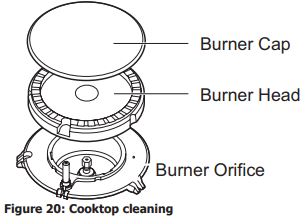
3. Use a toothbrush to clean all over the burner Use a toothbrush to clean all over the burner head.
4. Wipe the burner cap and head clean with a soft, clean cloth, sponge, or scratch-free cleaning pad. Wipe out burner orifice with a cloth before placing burner head and cap back on. The burner assembly must be completely dry before use.
5. Make sure the burner caps and heads are placed and seated properly over the ignitor. The three mounting legs on burner will align with slots on the orifice holder. When placed correctly, the burner cap should not move off the burner head (see “Assembly of the burner caps” on page 13).
6. If burner fails to light, recheck placement of burner head to the orifice holder and cap.
IMPORTANT
- Always keep the surface burner caps in place whenever a surface burner is in use.
- When replacing the burner caps, be sure the burner caps are seated firmly on top of the burner heads.
- Aluminum foil - Use of aluminum foil on a hot cooktop can damage the cooktop. Do not use thin aluminum cooking utensils or allow aluminum foil to touch the surface elements under any circumstances.
- Aluminum utensils - The melting point of aluminum is much lower than that of other metals. Care must be taken when aluminum pots or pans are used on the cooktop. If aluminum pans are allowed to boil dry when using the cooktop, not only will the utensil be damaged or destroyed, but it may fuse to, break, or mark the ceramic glass surface, permanently damaging the cooktop surface.
- For proper flow of gas and ignition of burners do not allow spills, food, cleaning agents, or any other material to enter the gas orifice port opening
Replacing the Oven Light
CAUTION Be sure the oven is unplugged and all parts are cool before replacing the oven light.
Replacing the oven interior light bulb:
The interior oven light is located at the rear of the oven cavity and covered with a glass shield. The glass shield must be in place whenever the oven is in use (Figure 21). Only use lamps with the same specifications.
1. Put a cloth on the bottom of the interior of the appliance. It prevents damage to the lamp glass cover and the cavity.
2. Turn electrical power off at the main source or unplug the appliance.
3. Turn the lamp glass cover counterclockwise to remove it.
4. Clean the glass cover.
5. Replace the lamp with a suitable 300°C heatresistant lamp.
NOTE Do not allow your fingers to touch the new bulb when replacing. This will shorten the life of the bulb. Use a paper towel or cotton glove while handling the new bulb when installing.
6. Replace glass oven lamp glass cover.
7. Turn power back on again at the main source (or plug the appliance back in).
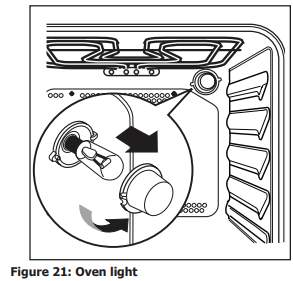
Removing and Replacing the Oven Door
To remove the oven door:
- Open the door fully, horizontal with the floor, and hold the two door hinges (Figure 22).
- Lift and turn/pull the levers on both of the door hinge locks down from the oven frame completely towards the oven door (Figure 23). A tool such as a small flat-blade screwdriver may be required.
- Firmly grasp both sides of oven door along the door sides. Do not use the oven door handle. Close the oven door halfway to the first opening position. Then, pull forward and remove the door from its seat (Figure 24).
- Put the door on a soft cloth on a stable surface (Figure 25).
- Clean the glass panel with water and soap. Dry the glass panel carefully
IMPORTANT Clean the oven door with a wet sponge only. Dry it with a soft cloth. Do not use steel wool, acids or abrasive materials as they can damage the oven surface. Clean the oven control panel with the same precautions.
IMPORTANT Special door care instructions - Most oven doors contain glass that can break. Do not close the oven door until all the oven racks are fully in place. Do not hit the glass with pots, pans, or any other object. Scratching, hitting, jarring, or stressing the glass may weaken its structure causing an increased risk of breakage at a later time.
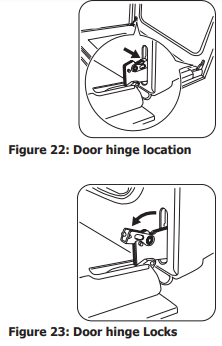

IMPORTANT Special door care instructions - Most oven doors contain glass that can break. Do not close the oven door until all the oven racks are fully in place. Do not hit the glass with pots, pans, or any other object. Scratching, hitting, jarring, or stressing the glass may weaken its structure causing an increased risk of breakage at a later time.
To replace the oven door:
- Firmly grasp both sides of oven door along the door sides. Do not use the oven door handle (Figure 24).
- Holding the oven door at the same angle as the removal position, seat the hook of the hinge arm over the roller pins located on each side of the oven door frame (Figure 24). The hook of the hinge arms must be fully seated onto the roller pins.
- Fully open the oven door, horizontal with floor (Figure 22).
- Lift and turn/push the levers on both of the door hinge locks up towards and into the oven frame to the locked position (Figure 23).
- Close the oven door.
Aluminum Foil and Utensils
WARNING
- Never cover any slots, holes, or passages in the oven bottom or cover an entire oven rack with materials such as aluminum foil. Aluminum foil linings may trap heat, causing a fire hazard.
- Protective Liners — Do not use aluminum foil to line the oven bottom. Improper installation of these liners may result in risk of electric shock or fire.
IMPORTANT
- Aluminum foil - Use of aluminum foil on a hot cooktop can damage the cooktop. Do not use thin aluminum cooking utensils or allow aluminum foil to touch the surface elements under any circumstances.
- Aluminum utensils - The melting point of aluminum is much lower than that of other metals. Care must be taken when aluminum pots or pans are used on the cooktop. If aluminum pans are allowed to boil dry when using the cooktop, not only will the utensil be damaged or destroyed, but it may fuse to or permanently damage the coil or cooktop.
BEFORE YOU CALL
For best cooking results, preheat the oven before baking cookies, breads, cakes, pies, pastries, etc. There is no need to preheat the oven for roasting meat or baking casseroles. The cooking times and temperatures needed to bake a product may vary slightly from your previously owned appliance.
| Baking Problems and Solutions Baking Problems | ||
| Baking Problems | Causes | Corrections |
|
Cookies and biscuits burn on the bottom.
|
Cookies and biscuits put into oven before oven is preheated. Rack position is too low. |
Allow oven to preheat to desired temperature before placing food in oven. Choose pan sizes that will permit at least 2” of air space. Use proper rack position for baking needs. |
|
Cakes too dark on top or bottom
|
Cakes put in oven before oven is preheated. Rack position too high or too low. Oven too hot. |
Allow oven to preheat to the selected temperature before placing food in the oven. Use proper rack position for baking needs. Set oven temperature 25°F (13°C) lower than recommended. |
|
Cakes not done in center
|
Oven too hot. Incorrect pan size. Pan not centered in oven. Glass cookware slow heat conductor. |
Set oven temperature 25°F (13°C) lower than recommended. Use pan size suggested in recipe. Use proper rack position and place pan so there are at least 2” (5.1 cm) of space on all sides of pan. Reduce temperature and increase cook time or use shiny bakeware. |
|
Cakes not level.
|
Oven not level. Pan too close to oven wall or rack overcrowded. Pan warped. Oven light left on while baking. |
Place a marked glass measuring cup filled with water on the center of the oven rack. If the water level is uneven, refer to the installation instructions for leveling the oven. Use proper rack position and place pan so there are at least 2” (5.1 cm) of space on all sides of pan. Do not use pans that are dented or warped. Do not leave the oven light on while baking. |
|
Foods not done when cooking time is over.
|
Oven too cool. Oven overcrowded. Oven door opened too frequently |
Set oven temperature 25°F (13°C) higher than suggested and bake for the recommended time. Be sure to remove all pans from the oven except the ones to be used for baking. Open oven door only after the shortest recommended baking time. |
Solutions to Common Problems
Before you call for service, review the following list. It may save you time and expense. Possible solutions are provided with the problem listed
| Problem | Cause / Solution |
| Entire appliance does not operate |
Appliance not connected. Make sure power cord is plugged properly into outlet. Check your fuse box or breaker box to make sure the circuit is active. Electrical power outage. Check house lights to be sure. Call your local electric company for service outage information. |
| Oven Problems | |
| Problem | Cause / Solution |
| Poor baking results. | Many factors affect baking results. Use proper oven rack position. Center food in the oven and space pans to allow air to circulate. Preheat the oven to the set temperature before placing food in the oven. Try adjusting the recipe's recommended temperature or baking time. |
| Oven light does not work. | Be sure the oven light is secure in the socket. See “Replacing the Oven Light” on page 25. |
| Flames inside oven or smoking from oven vent. | Excessive spills in oven. Grease or food spilled onto the oven bottom or oven cavity. Wipe up excessive spills before starting the oven. If flames or excessive smoke are present when using broil, see “Setting Broil” on page 21. |
| Oven racks discolored or do not slide easily. | Clean by using a mild abrasive cleaner following manufacturer's instructions. Rinse with clean water, dry, and replace in oven. |
| Oven smokes excessively when broiling. |
Incorrect setting. See “Setting Broil” on page 21. Meat too close to the broil element or burner. Reposition the broil pan to provide proper clearance between the meat and broil element or burner. Remove excess fat from meat. Cut remaining fatty edges to prevent curling, but do not cut into lean. Grease build up on oven surfaces. Regular cleaning is necessary when broiling frequently. Grease or food splatters will cause excessive smoking. |
| Areas of discoloration with metallic sheen on cooktop surface. | Mineral deposits from water and food. Remove them using cooktop cleaning creme applied to the ceramic surface. Buff with a non-abrasive cloth or sponge. |
| Appliance is not level. |
Be sure floor is level, strong, and stable enough to adequately support range. If floor is sagging or sloping, contact a carpenter to correct the situation. Poor installation. Place oven rack in center of oven. Place a level on the oven rack. Adjust leveling legs at base of appliance until the rack is level. Kitchen cabinet alignment may make range appear not level. Be sure cabinets are square and have sufficient room for appliance clearance. |
| Cooktop Problems | |
| Cannot move appliance easily. Appliance must be accessible for service. |
Cabinets not square or are built in too tightly. Contact builder or installer to make appliance accessible. Carpet interferes with appliance. Provide sufficient space so appliance can be lifted over carpet. |
| Entire appliance does not operate. |
Make sure power cord is plugged properly into outlet. Electrical power outage. Check house lights to be sure. Call your local electric company for service outage information. |
| Surface burners do not ignite. |
Surface control knob was not completely turned to LITE ( Burner ports are clogged. With the burner OFF and cool, use a small-gauge wire or needle to clean the burner head slots and ignition ports. See “Cleaning the Sealed Burners” in the Care & Cleaning section on page 24 for additional cleaning instructions. Range power cord is disconnected from outlet (electric ignition models only). Be sure the power cord is securely plugged into the power outlet. Circuit is broken. Check breaker box or fuse box. Electrical power outage. Burners may be lit manually. See “Setting Surface Controls” on page 15. |
| Surface burner flame uneven or only part way around burner cap. |
Burner slots or ports are clogged. With the surface burner OFF and cool, clean ports with a small-gauge wire or needle. If moisture is present after cleaning, lightly fan the flame and allow the burner to operate until flame is full. Burner caps are not seated properly. Check that all burner caps are level and seated correctly on the burner heads. See “Cleaning the Sealed Burners” in the Care & Cleaning section on page 24 for additional cleaning instructions. |
| Surface burner flame is too high. |
Surface control knob is set too high. Adjust to a lower flame setting. Burner caps are not seated properly. Check that all surface burner caps are level and seated correctly on the surface burner heads. See “Cleaning the Sealed Burners” in the Care & Cleaning section on page 24 for additional cleaning instructions. Incorrect L.P. conversion. Refer to L.P. conversion kit instructions to correct. |
| Surface burner flame is orange. |
Dust particles in main gas line. Allow the burner to operate a few minutes until flame turns blue. In coastal areas, a slightly orange flame is unavoidable due to salt content in the air. Incorrect L.P. conversion. Refer to L.P. conversion kit instructions to correct. |






